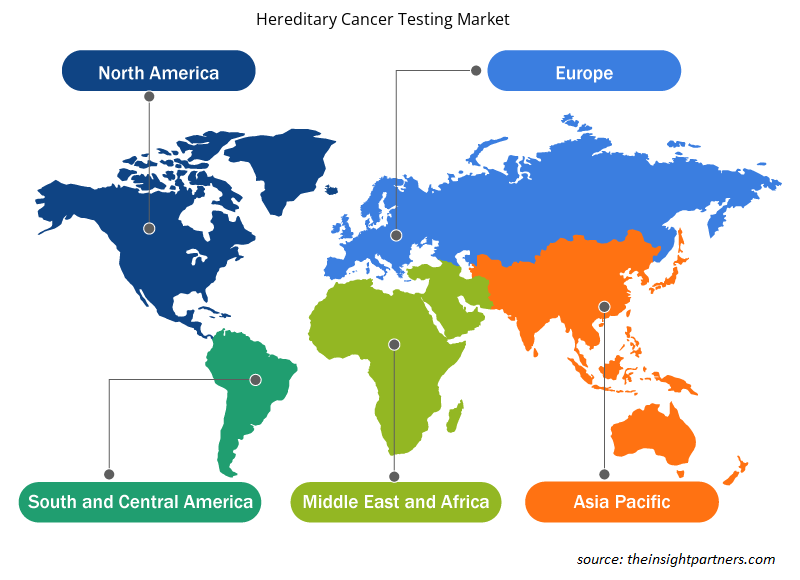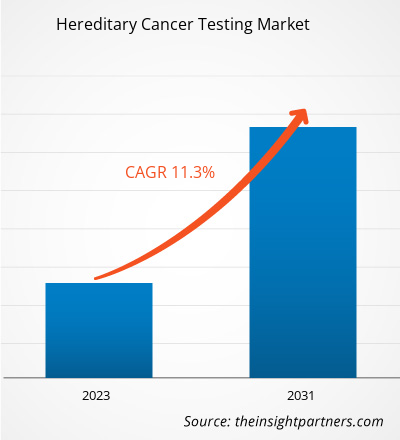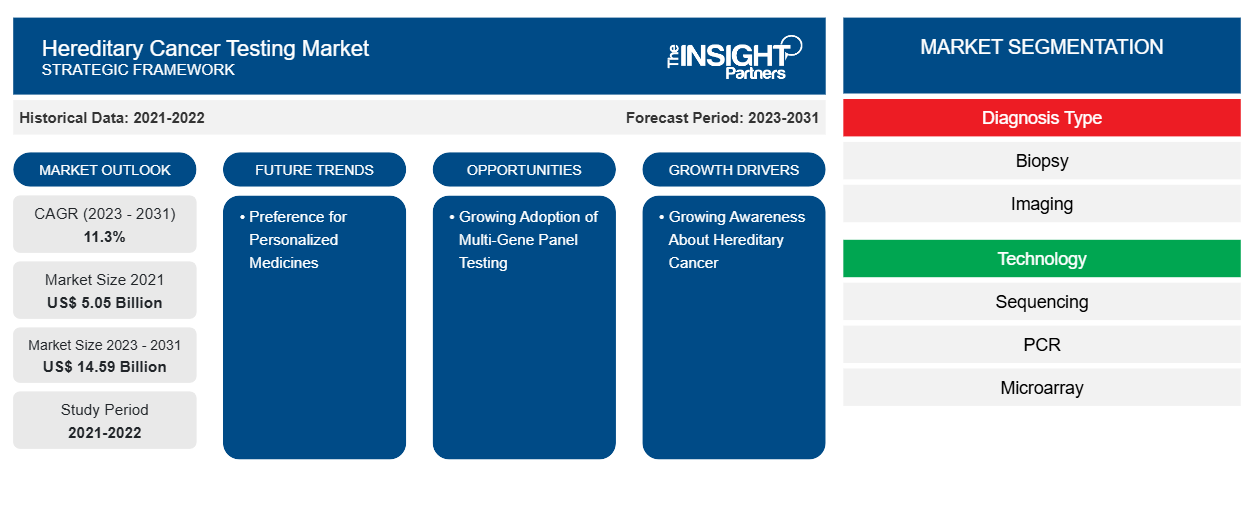La taille du marché des tests de cancer héréditaire a été estimée à 5,05 milliards USD en 2021 et à XX milliards USD en 2023 et devrait atteindre 14,59 milliards USD d'ici 2031 ; on estime qu'il enregistrera un TCAC de 11,3 % en 2023-2031. La prévalence croissante du cancer héréditaire et la sensibilisation croissante au cancer héréditaire sont des facteurs déterminants. La préférence pour les médicaments personnalisés restera probablement essentielle aux tendances du marché des tests de cancer héréditaire.
Analyse du marché des tests de dépistage du cancer héréditaire
Le cancer est une maladie génétique causée par des variations définies dans les gènes qui régissent le fonctionnement des cellules, affectant notamment leur croissance et leur réplication. Les mutations génétiques héréditaires sont à l’origine de 5 à 10 % de tous les cancers. Les chercheurs ont lié les mutations de gènes particuliers à plus de 50 syndromes cancéreux héréditaires affectant les individus qui développent certains cancers. De plus, environ 5 à 10 % des cancers du sein sont liés aux gènes mutés hérités des parents. Les variations dans les gènes BRCA1 et BRCA2 sont courantes. Les femmes porteuses d’une mutation BRCA1 ont un risque d’environ 72 % de développer un cancer du sein au cours de leur vie, tandis que celles porteuses d’une mutation BRCA2 ont un risque d’environ 69 %.
Aperçu du marché des tests de dépistage du cancer héréditaire
L'Asie-Pacifique est le marché qui connaît la croissance la plus rapide en matière de dépistage du cancer héréditaire. La région présente un énorme potentiel pour les acteurs du marché du dépistage du cancer héréditaire en raison du soutien gouvernemental de pays comme la Corée du Sud pour la sensibilisation au cancer et d'autres initiatives. La demande de séquençage génétique en Chine augmente, principalement en raison de l'augmentation de la classe moyenne, de la population âgée et de l'amélioration du système de santé du pays. Selon les données de l'OMS, le gouvernement chinois a mis en œuvre le plan « Healthy China 2030 », qui est utile à sa population.
Personnalisez ce rapport en fonction de vos besoins
Vous bénéficierez d'une personnalisation gratuite de n'importe quel rapport, y compris de certaines parties de ce rapport, d'une analyse au niveau des pays, d'un pack de données Excel, ainsi que de superbes offres et réductions pour les start-ups et les universités.
-
Obtenez les principales tendances clés du marché de ce rapport.Cet échantillon GRATUIT comprendra une analyse de données, allant des tendances du marché aux estimations et prévisions.
Moteurs et opportunités du marché des tests de cancer héréditaire
Sensibilisation croissante au cancer héréditaire
La sensibilisation aux maladies cancéreuses héréditaires s'accroît grâce aux divers efforts déployés par le gouvernement. Au cours de la dernière décennie, les communautés médicales, sanitaires et scientifiques publiques ont investi dans la sensibilisation aux maladies cancéreuses héréditaires, en mettant l'accent sur le risque de cancer héréditaire, les antécédents familiaux et les tests génétiques pour déterminer la responsabilité héréditaire en matière de cancer. En outre, les fabricants se concentrent sur l'adoption de stratégies telles que le lancement et l'approbation de produits, les investissements en R&D, le financement gouvernemental et les partenariats pour offrir un accès facile aux patients du monde entier. Par exemple, en avril 2024, Ambry a lancé la collaboration INTERACT (Inter-Organization Cancer Genetics Clinical Evidence Coalition) pour stimuler les tests de cancer héréditaire, dans le but d'accroître l'accès aux tests génétiques spécialisés.Ambry Launched the Inter-Organization Cancer Genetics Clinical Evidence Coalition (INTERACT) collaboration to spur hereditary cancer testing, aiming to increase access to specialized genetic testing.
Adoption croissante des tests multigéniques – une opportunité
Un panel multigénique permet d'éviter d'effectuer plusieurs tests pour différents types de cancer ou variantes. La variation du nombre de copies (CNV) est une source courante de variation génétique et est impliquée dans de nombreux troubles génétiques. C'est également un élément essentiel d'un diagnostic de cancer héréditaire.
Le gouvernement britannique et Genomic England ont annoncé que toutes les analyses CNV seront désormais réalisées par NGS plutôt que par amplification par sonde dépendante de la ligature multiplex (MLPA). Grâce à ses avantages, tous les processus de laboratoire seront rationalisés et permettront la détection de toutes les variantes SNV, INDEL et CNV à l'aide d'un flux de travail et d'un pipeline d'analyse uniques.
L’adoption de tests de panel multigéniques sera renforcée dans divers pays d’Amérique du Nord, d’Europe et d’Asie.
Analyse de segmentation du rapport sur le marché des tests de cancer héréditaire
Les segments clés qui ont contribué à l’élaboration de l’analyse du marché des tests de cancer héréditaire sont le type de diagnostic du produit, la technologie et l’utilisateur final.
- En fonction du type de diagnostic, le marché des tests de cancer héréditaire est segmenté en biopsie et imagerie. Le segment de la biopsie détenait la plus grande part de marché en 2023. Cependant, le segment de l'imagerie devrait enregistrer le TCAC le plus élevé au cours de la période de prévision.
- Sur la base de la technologie, le marché des tests de cancer héréditaire est segmenté en séquençage, PCR et microarray. Le segment du séquençage détenait la plus grande part de marché en 2023, et le même segment devrait enregistrer le TCAC le plus élevé au cours de la période de prévision.
- En fonction de l'utilisateur final, le marché des tests de cancer héréditaire est segmenté en centres de diagnostic, hôpitaux et cliniques. Le segment hospitalier détenait la plus grande part de marché en 2023. De plus, le même segment devrait enregistrer le TCAC le plus élevé du marché au cours de la période de prévision.
Analyse des parts de marché des tests de dépistage du cancer héréditaire par géographie
La portée géographique du rapport sur le marché des tests de cancer héréditaire est principalement divisée en cinq régions : Amérique du Nord, Asie-Pacifique, Europe, Moyen-Orient et Afrique, et Amérique du Sud/Amérique du Sud et centrale.
Le marché nord-américain des tests de dépistage du cancer héréditaire est segmenté entre les États-Unis, le Canada et le Mexique. Les États-Unis détenaient la plus grande part du marché nord-américain des tests de dépistage du cancer héréditaire en 2023. La croissance prévue du marché des tests de dépistage du cancer héréditaire en Amérique du Nord est tirée par le nombre croissant de patients atteints de cancer, l'augmentation du financement gouvernemental et l'incidence croissante des maladies génétiques au sein de la population aux États-Unis et au Canada au cours des dernières années. Le gouvernement a également pris des initiatives pour sensibiliser la population au cancer. Par exemple, l'American Society of Clinical Oncology (ASCO) propose un cours de sensibilisation au cancer pour diffuser des connaissances complètes et essentielles sur cette maladie, y compris la génétique du cancer héréditaire.
Aperçu régional du marché des tests de dépistage du cancer héréditaire
Les tendances et facteurs régionaux influençant le marché des tests de cancer héréditaire tout au long de la période de prévision ont été expliqués en détail par les analystes d’Insight Partners. Cette section traite également des segments et de la géographie du marché des tests de cancer héréditaire en Amérique du Nord, en Europe, en Asie-Pacifique, au Moyen-Orient et en Afrique, ainsi qu’en Amérique du Sud et en Amérique centrale.

- Obtenez les données régionales spécifiques au marché des tests de cancer héréditaire
Portée du rapport sur le marché des tests de dépistage du cancer héréditaire
| Attribut de rapport | Détails |
|---|---|
| Taille du marché en 2021 | 5,05 milliards de dollars américains |
| Taille du marché d'ici 2031 | 14,59 milliards de dollars américains |
| Taux de croissance annuel composé mondial (2023-2031) | 11,3% |
| Données historiques | 2021-2022 |
| Période de prévision | 2023-2031 |
| Segments couverts |
Par type de diagnostic
|
| Régions et pays couverts |
Amérique du Nord
|
| Leaders du marché et profils d'entreprises clés |
|
Densité des acteurs du marché des tests de dépistage du cancer héréditaire : comprendre son impact sur la dynamique commerciale
Le marché des tests de dépistage du cancer héréditaire connaît une croissance rapide, tirée par la demande croissante des utilisateurs finaux en raison de facteurs tels que l'évolution des préférences des consommateurs, les avancées technologiques et une plus grande sensibilisation aux avantages du produit. À mesure que la demande augmente, les entreprises élargissent leurs offres, innovent pour répondre aux besoins des consommateurs et capitalisent sur les tendances émergentes, ce qui alimente davantage la croissance du marché.
La densité des acteurs du marché fait référence à la répartition des entreprises ou des sociétés opérant sur un marché ou un secteur particulier. Elle indique le nombre de concurrents (acteurs du marché) présents sur un marché donné par rapport à sa taille ou à sa valeur marchande totale.
Les principales entreprises opérant sur le marché des tests de cancer héréditaire sont :
- Hologic Inc.
- Royal Philips NV
- Quest Diagnostics Incorporated
- Myriad Genetics, Inc.
- Génétique du cancer inc.
- Société Invitae
Avis de non-responsabilité : les sociétés répertoriées ci-dessus ne sont pas classées dans un ordre particulier.

- Obtenez un aperçu des principaux acteurs du marché des tests de cancer héréditaire
Actualités et développements récents du marché des tests de dépistage du cancer héréditaire
Le marché des tests de dépistage du cancer héréditaire est évalué en collectant des données qualitatives et quantitatives issues de recherches primaires et secondaires, qui comprennent d'importantes publications d'entreprises, des données d'associations et des bases de données. Voici une liste des évolutions du marché des tests de dépistage du cancer héréditaire :
- Exact Sciences Corp. a annoncé le lancement du test de dépistage du cancer héréditaire Riskguard aux États-Unis. Ce test fournit un rapport personnalisé au patient qui comprend les risques génétiques et familiaux à l'aide d'un simple échantillon de sang ou de salive pour 10 cancers courants, notamment colorectal , endométrial, gastrique, pancréatique, du sein, de la prostate, de la peau, des ovaires, du rein et endocrinien. (Exact Sciences Corp /Communiqué de presse, février 2024)
- Devyser a annoncé le lancement de deux nouveaux produits, Devyser LynchFAP et Devyser BRCA PALB2. Ces kits offrent une analyse efficace, ciblée et fiable des gènes associés à un risque accru de cancer. Devyser LynchFAP fournit une solution complète pour analyser PMS2 et 9 autres gènes associés aux syndromes de cancer colorectal héréditaire (Source : Devyser, Communiqué de presse, juin 2023)
Rapport sur le marché des tests de dépistage du cancer héréditaire et livrables
Le rapport « Taille et prévisions du marché des tests de cancer héréditaire (2021-2031) » fournit une analyse détaillée du marché couvrant les domaines ci-dessous :
- Taille du marché et prévisions aux niveaux mondial, régional et national pour tous les segments de marché clés couverts par le périmètre
- Dynamique du marché, comme les facteurs moteurs, les contraintes et les opportunités clés
- Principales tendances futures
- Analyse détaillée des cinq forces de PEST/Porter et SWOT
- Analyse du marché mondial et régional couvrant les principales tendances du marché, les principaux acteurs, les réglementations et les développements récents du marché
- Analyse du paysage industriel et de la concurrence couvrant la concentration du marché, l'analyse de la carte thermique, les principaux acteurs et les développements récents
- Profils d'entreprise détaillés
- Analyse historique (2 ans), année de base, prévision (7 ans) avec TCAC
- Analyse PEST et SWOT
- Taille du marché Valeur / Volume - Mondial, Régional, Pays
- Industrie et paysage concurrentiel
- Ensemble de données Excel
Rapports récents
Rapports connexes
Témoignages
Raison d'acheter
- Prise de décision éclairée
- Compréhension de la dynamique du marché
- Analyse concurrentielle
- Connaissances clients
- Prévisions de marché
- Atténuation des risques
- Planification stratégique
- Justification des investissements
- Identification des marchés émergents
- Amélioration des stratégies marketing
- Amélioration de l'efficacité opérationnelle
- Alignement sur les tendances réglementaires























 Obtenez un échantillon gratuit pour - Marché des tests de dépistage du cancer héréditaire
Obtenez un échantillon gratuit pour - Marché des tests de dépistage du cancer héréditaire